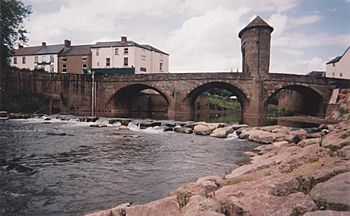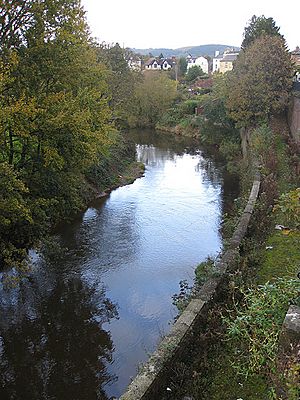River Monnow facts for kids
Quick facts for kids River Monnow |
|
|---|---|

The Monnow Bridge in Monmouth
|
|
| Native name | Afon Mynwy |
| Country | Wales, England |
| Physical characteristics | |
| Length | 42 mi (68 km) |
The River Monnow (which is Afon Mynwy in Welsh) is a river that forms part of the border between England and Wales. It is about 42 miles (68 km) long. The river flows through Herefordshire in England and Monmouthshire in Wales. It joins the River Wye near the town of Monmouth.
The Monnow starts high up on Cefn Hill, near Craswall, in the Black Mountains of Wales. It flows south, picking up water from smaller rivers called tributaries. These include the Escley Brook, Olchon Brook, and the River Honddu. The River Dore, which is its largest tributary, joins the Monnow near Pontrilas.
At Monmouth, the Monnow meets the River Wye. The famous Monnow Bridge in Monmouth is a very old bridge from the Middle Ages. It is special because it is the only fortified river bridge in Great Britain that still has its original gate tower standing on the bridge.
A long walking path, called the Monnow Valley Walk, follows the river for about 40 miles (64 km).
Contents
What Does the Name Monnow Mean?
The name River Monnow comes from the Welsh language. In Welsh, it is Afon Mynwy. The name means "swift water."
- Myn means swift.
- Wy is one of the Welsh words for water.
Fish in the River Monnow
The River Monnow was once very famous for its large number of brown trout. People caught record amounts of trout between Pontrilas and Skenfrith. However, the number of trout dropped a lot during the 1900s, especially after the 1960s.
In recent years, the trout fishing has gotten much better. The Monnow is now one of the best places in England and Wales to catch wild trout. It is also known for its grayling fish.
A new fish pass was opened in Monmouth. This helps fish like Atlantic salmon and sea trout swim past a dam that used to block their way. In 2008, salmon were seen jumping at the Kentchurch weir, which had not happened for many years.
The Monnow Rivers Association has helped a lot with improving the fishing. They work to make the river a better home for fish. They also encourage people who fish to release most of the fish they catch back into the water safely.
Generating Electricity from the River
At Osbaston, just north of Monmouth, there is a special project called the Monmouth New Hydro Scheme. This project uses the flow of the Monnow River to make electricity. It produces 670,000 kilowatt-hours of electricity each year. This is enough to power many homes.
The Osbaston site also has a fish pass. This helps fish and other water creatures move past the dam, which would otherwise block their journey up or down the river.
See also
 In Spanish: Río Monnow para niños
In Spanish: Río Monnow para niños


